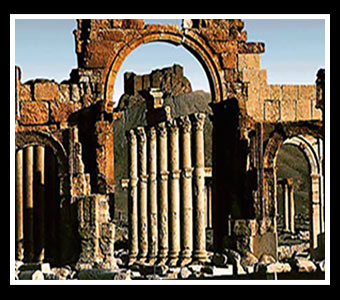History of the Persian architecture.
The Achaemenid Period:

The Achaemenid influenced by the Greeks, the Egyptians, and from other provinces of the Persian Empire that evolved a great style in which relief sculpture is used to massive architectural complexes.
The palace foundations of Cyrus at Pasargadae, of Artaxerxes at Susa, and above all extensive remains of the magnificent palace complex of Darius I at Persepolis reveal plans that characteristically show great columned audience halls.
In front of the halls were porticoes, flanked by square towers and set on high terraces. The palaces were approached by double flights of steps converging at the top. Although there are marked analogies to Egyptian, Greek, and Assyrian architecture, but the style as a whole and the feeling for space are distinctive.
The Persepolis columns are slenderer and more closely fluted than columns of Greece. Bases are high, often bell-shaped; capitals are composed of the foreparts of two bulls set back to back or of other animals above volute with rosette ornament.
The stylization of sculptures is subtly combined with effects of realism. And are the low stone reliefs of a procession of tribute bearers that decorate the great double staircase approaching the audience hall of Persepolis and the famous Frieze of Archers, executed in molded and enameled brick, a technique and style of Babylonian-Assyrian origin. Also found great detail in the gold and silver Rhytons, bowls, jewelry, and other objects produced by the Achaemenid culture.
The Parthian and Sassanid period:
After the death of the Great Alexander, was synthesizing Hellenistic motifs with Iranian forms, Buildings of dressed stone and rubble and brick were decorated with sculpted heads and mural paintings.
More the artistic importance is the contribution of the Sassanids that the expanding previous styles and techniques, a great palace with a huge barrel vault was constructed of rubble and brick.
Sassanid architecture is decorated with carved stone reliefs and makes use of colorful stone mosaics. Beautiful gold and silver dishes, bowls, and ewers, often decorated with hunting scenes or animals in high relief, and textiles with symmetrical heraldic designs.
The Sassanids recorded their triumphs on immense outdoor rock reliefs scattered throughout Iran, and using the same sites that the Achaemenids had covered with reliefs.
The Islamic art period in Iran:
Persian art and style in Syria is very strong. A significant innovation by the Iranians is the raising of a dome over a square hall by means of squelches. Also they used of stucco decoration, various intricate motifs, and ever symmetry.
The earliest important Islamic monument extant in Iran is the mausoleum of Ismail the Samanid at Bukhara. It is square building in cut-brick style, covered by a dome. During this early period, ceramics were raised to a major art form and art style.
The finest artworks of this period were the calligraphy wares of Nishapur and Samarkand. The star-shaped tomb tower of Qabus presents a form with far reaching influence. The art pottery and metalwork were further developed under the Seljuk Turks in the 11th and 12th century. The Luster glaze and minai ceramics using overgrazes enamel colors including leaf gilding with intricate scenes of court life, were produced at Ray, Kashan, and elsewhere of Iran.
The Mongol and Timurid Periods:
The Mongol invasions of the first half of the 13th century destroyed many towns and much artworks. Persian painting of this period that called Mongol school is in the 14th cent. The most famous artwork of this period is the magnificent Shah Nameh.
This great book has been divided up, and many leaves are in American collections and museums. The pictures are large, dark in color, and with landscape playing an important role. Small Shahnamehs have simple illustrations in yellow, red, blue, and gold.
The Timurid painting of the 15th century employs smaller figures and more static compositions. Chinese influences have been integrated and patterned symmetry reemerges. Behzad, the greatest master and painter in this art style, is renowned for his fine, firm line and exquisite delicacy. The Blue Mosque at Tabriz, named for its brilliant faience casing, is contemporary. The covered architecture by tiles, reached its in 16th-century Isfahan in the great building complex Square Shah.
The Safavid Dynasty:
Under the Safavid dynasty palaces were decorated with mural paintings, which have been heavily restored. Single-figure, portraits and ink drawings were also made for the Safavid period. In book illustrations of the Safavid, figures became sinuous, color and pattern ran riot, and the effect was that of ornate jewelry. A masterpiece of Safavid book illumination was the Shah Nameh of Shah Tahmasp, which incorporates the greatest developments in painting of the early 1520 s to the mid-1530s.
Later Developments in the Persian art and architecture:
In the 17th-century the Persian art, Iranian art architecture fell under European and Indian influences and so that rapidly degenerated. Under the Qajar dynasty (1779 -1925) a distinctive, the article style was developed in architecture, painting, artwork and the decorative arts. This art style so called Neo-Achaemenid style, which characterizes the public buildings of modern Tehran, points to a conscious effort at reviving and integrating the ancient heritage and Persian old art style in modern Iran.
© Fa.asadi Artwork Collection.
